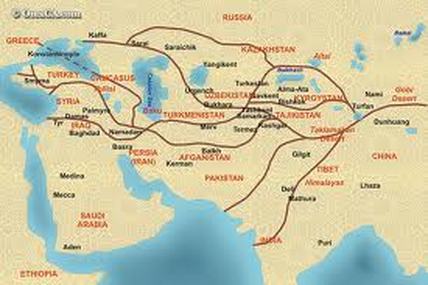
Significance to Global Trade:
The silk trading network was one of the most sophisticated and widely used trading systems in the world. It stretched from China to the Mediterranean Sea allowing cultural and economic interaction between the East and the West. By the 1500s Asian trade had slipped to the Portuguese after Vasco De Gama circumnavigated Africa in 1498, establishing a sea route. Silk became an essential part of both eastern, western, and intra-Asian trade. In the Early Modern Period China, Persia, and Bengal were the most important suppliers of raw silk to Europe. This was true until Ming China placed restrictions on their trade which included an export ban that caused Malacca (present-day Malaysia) to become the main port of trade with the westerners. Portuguese trade was intra-Asian and Macao in southeast China was colonized by the Portuguese in 1557 to facilitate trade with Japan. Japanese trade consisted mostly of Chinese silks bought using New World Silver and in return supplied the world with Japanese Silver. This trade resulted in silk becoming widely available in the New World especially in Peru which lead to the seventeenth century Peruvian ban on blacks wearing silk. In 1718 and 1720 silk imports to the Spanish Americas were prohibited due to the slow production of silver.
The Qing government, in 1683, lifted the export ban. As a result of this Chinese foreign trade rose but didn't have much impact since the rest of the world had already been using a complex and sophisticated intra-Asian trade that was very effective.
The Dutch East India Company was a dominant trading force in 17th century Asia. They entered the Asian silk trade in 1604 after benefiting from capturing Portuguese merchant ships. After this Amsterdam became an important silk market in Europe. At this time Taiwan was an important source for Chinese silk to Japan. Although other silks from Persia and Bengali were traded, Chinese silk was still the most desirable import. From around 1700 to 1760 Bengali silk was an important commodity until the Bengal Revolution in 1757 damaged the silk industry and caused the English to focus on obtaining silk from Canton (present-day Guangzhou) in China. International demand for silk swamped the silver-based Chinese economy with Japanese and New World silver. The Dutch brought less silk to Europe and more to Japan for the Japanese silver which was desired and more valuable. In 1759 the English East India Company usurped the Dutch position in China and was trading through Canton. That year exports were so high that the exportation of raw silk was banned to keep weavers from being impoverished.
The silk trading network was one of the most sophisticated and widely used trading systems in the world. It stretched from China to the Mediterranean Sea allowing cultural and economic interaction between the East and the West. By the 1500s Asian trade had slipped to the Portuguese after Vasco De Gama circumnavigated Africa in 1498, establishing a sea route. Silk became an essential part of both eastern, western, and intra-Asian trade. In the Early Modern Period China, Persia, and Bengal were the most important suppliers of raw silk to Europe. This was true until Ming China placed restrictions on their trade which included an export ban that caused Malacca (present-day Malaysia) to become the main port of trade with the westerners. Portuguese trade was intra-Asian and Macao in southeast China was colonized by the Portuguese in 1557 to facilitate trade with Japan. Japanese trade consisted mostly of Chinese silks bought using New World Silver and in return supplied the world with Japanese Silver. This trade resulted in silk becoming widely available in the New World especially in Peru which lead to the seventeenth century Peruvian ban on blacks wearing silk. In 1718 and 1720 silk imports to the Spanish Americas were prohibited due to the slow production of silver.
The Qing government, in 1683, lifted the export ban. As a result of this Chinese foreign trade rose but didn't have much impact since the rest of the world had already been using a complex and sophisticated intra-Asian trade that was very effective.
The Dutch East India Company was a dominant trading force in 17th century Asia. They entered the Asian silk trade in 1604 after benefiting from capturing Portuguese merchant ships. After this Amsterdam became an important silk market in Europe. At this time Taiwan was an important source for Chinese silk to Japan. Although other silks from Persia and Bengali were traded, Chinese silk was still the most desirable import. From around 1700 to 1760 Bengali silk was an important commodity until the Bengal Revolution in 1757 damaged the silk industry and caused the English to focus on obtaining silk from Canton (present-day Guangzhou) in China. International demand for silk swamped the silver-based Chinese economy with Japanese and New World silver. The Dutch brought less silk to Europe and more to Japan for the Japanese silver which was desired and more valuable. In 1759 the English East India Company usurped the Dutch position in China and was trading through Canton. That year exports were so high that the exportation of raw silk was banned to keep weavers from being impoverished.
